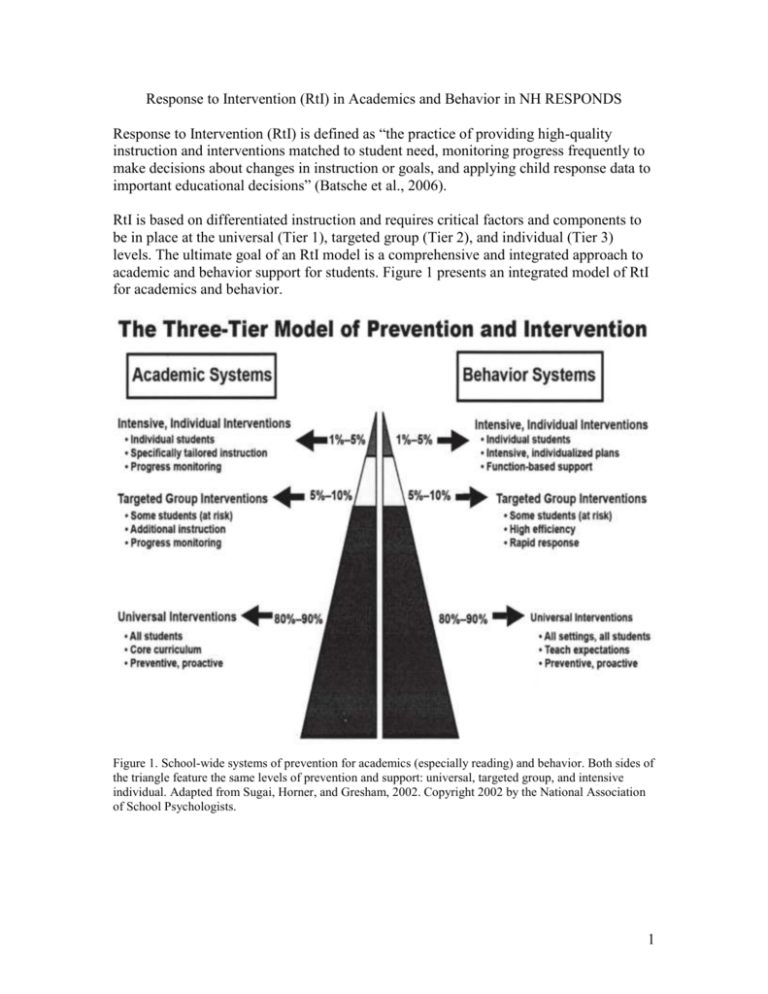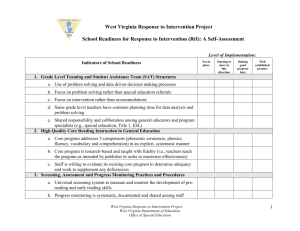Overview of RTI for Behavior and Literacy
advertisement

Response to Intervention (RtI) in Academics and Behavior in NH RESPONDS Response to Intervention (RtI) is defined as “the practice of providing high-quality instruction and interventions matched to student need, monitoring progress frequently to make decisions about changes in instruction or goals, and applying child response data to important educational decisions” (Batsche et al., 2006). RtI is based on differentiated instruction and requires critical factors and components to be in place at the universal (Tier 1), targeted group (Tier 2), and individual (Tier 3) levels. The ultimate goal of an RtI model is a comprehensive and integrated approach to academic and behavior support for students. Figure 1 presents an integrated model of RtI for academics and behavior. Figure 1. School-wide systems of prevention for academics (especially reading) and behavior. Both sides of the triangle feature the same levels of prevention and support: universal, targeted group, and intensive individual. Adapted from Sugai, Horner, and Gresham, 2002. Copyright 2002 by the National Association of School Psychologists. 1 Readiness for RtI in Academics and Behavior in NH RESPONDS School districts interested in RtI recognize the reciprocal, reinforcing relationship between academics and behavior and, as such, are deeply commitment to the integration of academics and behavior systems of support. There is great risk in thinking about and addressing initiatives separately, not the least of which is that faculty see them as a competition, pitting one against the other, and ultimately making choices about which one to devote their time, energy and resources. In practice, this means that a school district which applies to NH RESPONDS must see both academic achievement and behavior support as top priorities for school improvement. The commitment to an integrated approach requires a district-wide leadership team that addresses both areas in their planning, implementation and sustaining of instructional systems, practices and data. It also requires that each school commits to developing a single unified team at each tier of prevention and intervention to oversee development, implementation and sustainability in an effort to maximize resources and efficiencies in service delivery. The ultimate goal in participation in NH RESPONDS is for schools to have a highly developed integrated 3-tier system of academics and behavior support at the end of the grant period. In order to achieve success during the grant period, each school that is selected for participation must show readiness through commitments for a preventative and integrated approach to teaching academic and social behavior and evidence of prior success in implementation in at least one of the two areas. The rationale for requiring the recipient school district to show sound implementation in at least one area and readiness for the other area to be selected is simply that, in three years, it would be hard to take a school, even with excellent readiness in both areas, to multiple levels of implementation in both academics and behavior. Therefore, a school with solid implementation of universal positive behavioral interventions and supports (PBIS) and readiness for beginning universal literacy support would be a good candidate as would a school with the opposite profile. In either case, the school district leadership team in conjunction with the school will work with NH RESPONDS staff on an initial assessment and action planning process to determine which area to prioritize for training as it’s likely they can’t afford to have staff simultaneously trained in both. It might come to pass that the school district chooses to begin working on an evidenced-based approach to universal literacy supports followed by training in the development and implementation of a secondary approach to either literacy or behavior. 2




